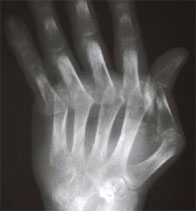 |
|
Nowadays people suffer more from pain in joints than from any other ailments. And this is due to changes in our life style; our jobs and leisure activities have become more sedentary.
Arthritis means inflammation of a joint. Generally people perceive it as any kind of pain or discomfort related with body movement or general stiffness or pain in the joints. |
|
|
|
|
|
|
|
| Causes of Arthritis |
As a result of a disease.
An infection.
Connective tissue disorder.
A genetic defect.
Due to aging process.
Autoimmune disorder. |
| Types of Arthritis |
There are many types of arthritis. Here we only discuss common types:
Rheumatoid arthritis
This is the commonest form of chronic inflammatory joint disease. It is also known as rheumatism or synovitis. It usually affects people over 40 years of age and females are more prone. It affects small and large peripheral joints, with systemic disturbance to other parts of body, including the heart, lungs, eyes, nerves and muscles.
The discomfort of rheumatoid arthritis develops slowly and tends to be most severe on awakening. Rheumatoid arthritis in older people may cause deformity of hands and feet as muscles weaken, tendons shrink, and the ends of bone become abnormally enlarged.
If the treatment is started at the early stage of disease it gives relief in most people. Generally symptoms may progresses for five years or more, eventually they tend to stabilize or decline the movement of joints. So, permanent disability can be prevented by early treatment.
Juvenile rheumatoid arthritis
It is an inflammatory arthritis characterized by persistently negative tests for rheumatoid factor associated with numbers of other common features like chronic fever and anemia, and secondary effects on the heart, lungs, eyes and nervous system. It commence in childhood before the age of 16 years.
In some cases, juvenile rheumatoid arthritis presents with high fever, pericarditis, mono or polyarticular synovitis, with progressive erosion of cartilage. Here, rheumatoid factor is not present in blood. This typical type is called still’s disease.
In children younger than the age of five juvenile arthritis attacks can last for weeks and recurrence is also possible but symptoms may be less severe. Patients require heavy physical therapy and exercise. Now-a-days permanent damage is rare.
Infectious arthritis
Infective arthritis can accompany septicemia at any age. It is usually a complication of an injury or another disease. It is less common than arthritic conditions that come on with age. Symptoms have an abrupt onset with severe pain and swelling of a single joint associated with a swinging fever, severe malaise or primary injury.
Large joints (arms and leg joints) are most frequently affected. Generally joint is hot, tender and swollen with marked limitation of movement. The diagnosis may be missed and if left untreated, can result in permanent disability.
Osteoarthritis
It is also known as arthrosis or degenerative joint disease. It is not a single disease. Rather it is the end-result of a variety of patterns of joint failure. It is a degenerative and destructive disorder of the hyaline cartilage and adjacent bone of joints. It is most common form of arthritis, particularly in the elders. In osteoarthritis, the protective cartilage at the end of bones in joints, gradually wears away and the inner bone surfaces become exposed and rub together.
It generally confines to one or only a few joints in majority of patients. The joints most frequently involved are those of the spinal joints, hips and knee joints (weight-bearing joints).
The mechanism of osteoarthritis is generally unknown, but some people have genetic predisposition. Misuse of steroids can also bring an early onset of disease. It may be due to trauma, joint malalignment, foreign bodies and damaged cartilage from septic arthritis.
The symptoms are gradual in onset; pain and stiffness develops gradually. Pain is usually made worse by exercise, whereas stiffness in the morning or after inactivity improve with movement. As the disease progresses, movement in the affected joint becomes increasingly limited, and tenderness and grating sensation develop and crepitus may be felt on joint movement. Overgrowth of all tissues in and around the joint causes joint enlargement. Associated muscles wasting occur as the disease progresses, causing increasing instability and joints become more prone to injury. Locking of joint may occur, if bony outgrowths (osteophytes) protrude into the joint cavity.
Other arthritic conditions include ankylosing spondylitis (arthritis of the spine), bone spur (bony growths on the vertebrae or other areas), gout (crystal arthritis), and systemic lupus (inflammatory connective tissue disease).
Healthy joint—Cartilage cushions the ends of bones at contact points. Synovial membrane lines the joint cavity and secretes synovial fluid to lubricate the joint.Rhematoid arthritis—Synovial membrane inflamed and excess fluid causes cavity to swell which causes cartilage to break down.Osteoarthrits—Gradual deterioration of cartilage after years of use causes rubbing between bone, creating friction and pain. |
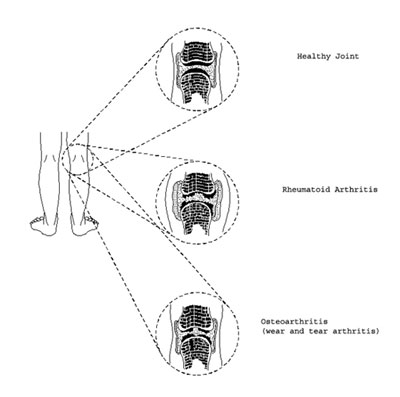 |
| Symptoms of Arthritis |
Rheumatoid arthritis
Pain, stiffness and inflammation of a number of peripheral joints like arms, legs, wrists, or fingers in the same side or on both sides of the body.
Early morning stiffness.
Joints are red and swollen.
Systemic onset with fever, weight loss, profound fatigue and malaise.
If profound, destruction of peripheral joints.
Juvenile rheumatoid arthritis
Loss of appetite.
Weight loss.
Enlarged lymph glands and spleen.
Anemia.
Retardation of growth.
Blotchy rashes on the arms and legs.
Abdominal or chest pain.
Infectious arthritis
Fever.
Severe pain, swelling and tenderness of a single joint.
Large joints are more commonly affected.
Severe malaise.
Osteoarthritis
Commonly weight-bearing joints are involved like the hips, spines and knees.
Symptoms are gradual in onset.
Pain and progressive stiffness.
Movement of joints are restricted.
Lab Investigations in Arthritis
Rheumatoid arthritis
In addition to sign and symptom analysis, blood tests are commonly done to confirm the diagnosis. The majority of sufferers have antibodies called rheumatoid factor (RA factor).
Investigation shows high CRP and RA Factor.
X-ray findings.
Infectious arthritis
Testing a sample of fluid from the affected joints.
Blood culture.
Osteoarthritis
X-ray shows loss of joint space and formation of marginal osteophytes.
Consult a Doctor if
Pain and stiffness come on quickly, whether from an injury or an unknown cause.
A child has swinging fever, weight loss and loss of appetite associated with pain or a rash on armpits, knees, wrists, and ankles.
Joint pain associated with fever.
Yoga and Arthritis
Daily yoga practice may help loosen stiff, arthritis joints.
Try the exercises shown here for painful joints:
Spider push-up for joints of hand. Press your fingertips together firmly, holding your palms two to three inches apart. Then push your palms toward each other while keeping your fingertips touching and with your fingertips still together move them apart, relax, then repeat this 20 times. |
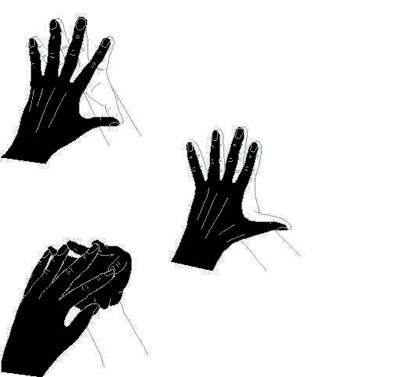 |
| Thumb squeezer to ease stiff finger joints. Curl your fingers into a fist around your thumb, gently squeeze, then slowly release. Repeat this 10 times with each hand. |
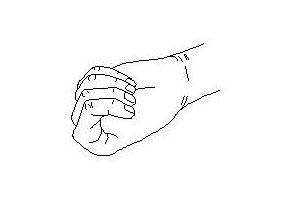 |
| ‘C’ exercise – Do this exercise on your palms and knees in the table position; exhale and swing your head and buttocks as far to the left as you can. Breathe deeply as you hold this position for 10 second, exhale as you slowly straighten your back, and then do the same movement to the right. Repeat this 10 times. |
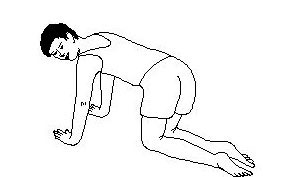 |
| Dog and Cat – The dog and cat helps to stretch your hips and back. On your palms and knees in table position, inhale as you lower your back and lift your head and buttocks (Dog). Then exhale as you arch your back and drop your head and buttocks (Cat). Repeat it 10 times. |
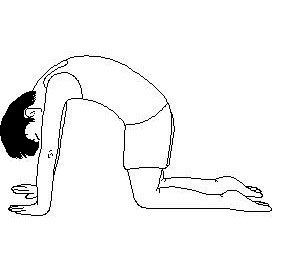 |
Diet and Nutrition in Arthritis
Avoid overeating and don’t eat too quickly.
Chew everything very thoroughly.
Don’t be anxious or stressed at meal time.
What to eat in arthritis
All alkaline forming foods, which include generally all fruits and vegetables except pulses, asparagus, peas, broad beans, Brussels sprouts. Other alkaline forming foods are millet, yoghurt, fresh coconut, soya product and egg white.
Bananas, pineapples, apples and grapes.
Carrot, celery, beetroot, parsley, alfalfa, garlic, mushrooms.
Fruits – all berry fruits, blueberries, blackberries and cherries.
Sprouted grains, seeds and nuts.
Nuts and seeds, especially of sunflowers, sesame, walnuts, pumpkin seeds, almonds should be taken raw and fresh.
Grains – millet, rice, corn are the best. Use rye and oatmeal in moderation. Wheat causes many problems for many arthritis patients, so avoid it.
Goat’s milk or soya milk, egg and cottage cheese in moderation.
Oily fish.
Spirulina and wheat grass.
Turmeric and ginger.
Low-fat and low-protein vegetarian diet.
Raw and fresh, fruit and vegetable, juices are of enormous benefit to a patient. These must be freshly prepared and not canned or packed. Dilute the juice and drink slowly.
Garlic may be taken raw or cooked.
What to reduce in arthritis
All acid-forming foods, especially meat and dairy products. Home made cottage cheese is fine. All these products increase inflammation.
Citrus fruits - sometimes body does not metabolize these correctly.
Pulses.
What to avoid in arthritis
Foods to which you are allergic. Use trial and error, preferably under the supervision of a homeopathic physician.
Nightshade family : tomato, potato, pepper, capsicum, chili.
All wheat flour, and everything made from it - bread, pasta, cereal and cakes.
Sugar and artificial sweeteners.
Added salt and hot spices.
All frozen and processed foods - cakes, cereals, jams, sausages etc.
Coffee, tea, cocoa, alcohol and soft drink.
Homeopathic Treatment of Arthritis
In the treatment of arthritis, we generally use three stage therapy which consists of medication to relieve pain and inflammation, rest to let the injured tissues heal themselves, and exercise to rebuild strength and mobility.
In homeopathy, there are various remedies for arthritis and the patient’s exact remedy is decided by taking his complete history and then selecting the remedy which best suits his or her constitution with certainty to cure.
Thus homeopathy is tailor-made while allopathy is ready-made because in allopathy all patients are given the same medicine without considering their individual reactions and disease modalities.
Mostly, patients tell that their pains get worse or better in certain environmental conditions.
Some patients come and tell that they get rheumatic inflammation of joints with unbearable pains after being exposed to cold dry air. The patient is very fearful and restless and the pain gets worse at night. Homeopathy remedy Aconite napellus 30c would relieve the suffering in such a case.
Some patients may come and say that their pains get worse from the slightest movement; they want to lie down and do not want to move. They do not like to be disturbed and are averse to company. There is a lot of irritability. The patient also has increased thirst. In such a case homeopathic remedy Bryonia alba 30c comes into play.
Another patient may get worse from cold damp weather. He is worse getting wet. This patient is very restless, better from movement, and better from dry warm applications. In such a case homeopathy medicine Rhus toxicodendron 30c is prescribed.
In allopathy, the treatment is suppressive with painkillers which have dangerous side effects which include damage to kidneys and liver. Homeopathy cure for arthritis aims at dealing with the cause of pain and thus curing arthritis from its root.
Even if you are already taking allopathic painkillers then also homeopathy would benefit you. It would gradually reduce your dependence on painkillers and you would start using them in emergency only and after continuous homeopathic therapy for your arthritis your dependence on painkillers will totally vanish.
Homeopathy cure for arthritis make you more healthy and mobile with reduced or no pain at all. And the most important thing is that the homeopathic medicines for arthritis and joint pains are totally free from side effects and are safe for longterm use. |
|